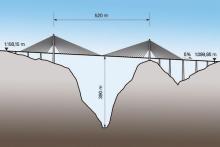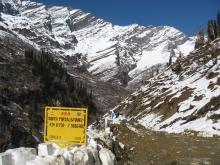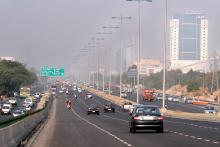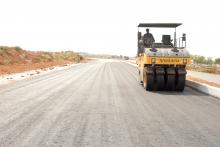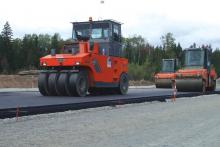With economies booming in the BRIC countries and other regions, spending on infrastructure is at a high - Patrick Smith reports As economic crisis grips much of the world, many countries are still spending billions on infrastructure to improve transportation. While the USA and Europe struggle with debt problems (and this has affected much of the rest of the world) the development of highways, airport, ports and other infrastructure is gathering pace in other regions to boost economic developments.
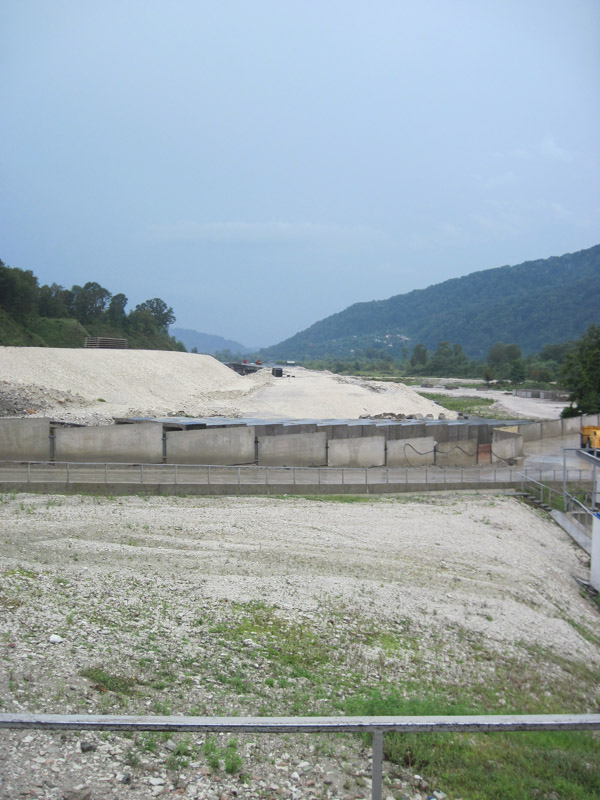
Russia is spending billions on roads. This road Sochi is for the 2014 Winter Olympics
With economies booming in the BRIC countries and other regions, spending on infrastructure is at a high - Patrick Smith reports
As economic crisis grips much of the world, many countries are still spending billions on infrastructure to improve transportation.While the USA and Europe struggle with debt problems (and this has affected much of the rest of the world) the development of highways, airport, ports and other infrastructure is gathering pace in other regions to boost economic developments.
For example, Russian Prime Minister Vladimir Putin recently announced that his country will spend US$285 billion over the next ten years to double the rate of road building to tackle what is a sensitive issue for Russians.
It is understood that opinion polls suggest that Russians are increasingly concerned with road quality as the number of cars doubled to 40 million in the last decade and is expected to reach 60 million by 2020.
In a report, the World Bank has said that Russia's highway infrastructure is seen as one of the key restrictions for economic growth, with only a third of all federal roads meeting quality standards.
In a speech at a local government meeting, Putin is reported as saying: "The state of our roads is a real problem, constraining business activity, investment and development of the Russian territories.
"Our financial resources allow us to double road construction volumes in the next ten years." Indeed, it is new-found financial muscle that is allowing countries in Asia, Latin America and to some extent Africa, invest heavily in infrastructure, or lose out on lucrative export routes.
However, road construction spending in Russia, which is ranked 124th in the World Economic Forum's road quality rating, increased 40% to $25 billion in 2011. Last year a motorway linking European Russia to its far east was completed, and many more are in the pipeline.
Only recently, a civil engineering tender worth U$4.73 billion for work in Saint Petersburg, was awarded to a consortium of Russian, Italian and Turkish companies.
The consortium is led by Russian bank VTB and also consists of Italian civil engineering group
The contract covers the construction of an 11km road bypass and bridge between the city's port and its residential districts.
In a separate development, about $3.92 billion will be allocated for road construction in the Russian capital Moscow in 2012 under a targeted investment programme of the city.
About $4.9 billion will be invested in 2013 and $5 billion in 2014.
A special government budget for motorway building at federal and regional levels was set up in 2011, and this will accumulate revenue from sources such as fuel excise duty and vehicle licensing tax, which will be channelled into road construction.
Meanwhile India, whose infrastructure is ranked 91 out of 139 nations by the World Economic Forum's Global Competitiveness Index, has said it will award $12 billion of highway construction projects in the financial year, its biggest expansion, as the nation aims to remove infrastructure bottlenecks that again hinder economic growth. Indeed, the focus on the road sector will boost GDP and indirectly help the manufacturing sector.
The 7,300km project includes new expressways as well as widening of existing roads through to the end of March, 2012.
J.N. Singh, finance chief of
In recent years, India has upgraded many of its major routes linking its four major cities, Delhi, Mumbai, Chennai and Kolkata (the Golden Quadrilateral), and the NHAI is accelerating road construction as India aims to spend $1 trillion in the five years to 2017 to improve its infrastructure.
Plans to reach a target of building 20km of highway/day have not yet been met, completing just 12km/day since April 2007, according to the NHAI website, while the acquisition of land for factories and highways has sparked rioting and held up an estimated $100 billion of projects across India.
"The works we award now will get us to the target of 20km a day in three years. Building 1km of a six-lane highway needs an investment of 130 million rupees [$2.8 million]," Singh is reported as saying.
The NHAI, responsible for implementing the highway development programme, gets part of its money from a levy on the sale of fuel, tolls and the sale of bonds, and in the five years to March, 2011 it has awarded 12,034km of road projects.
Companies that win the contract will build roads and collect tolls for up to 30 years before transferring them to the state, Singh said.
The nation's push to upgrade its infrastructure has prompted heavy equipment makers including
Earlier in 2011, at the first bc India exhibition in Mumbai, organised by Messe München International and the
The company also said it was looking to strengthen the Chetra brand in the southeastern Asia countries, in particular in Malaysia, Indonesia, Thailand, South Korea and Australia where its machines are already in operation.
Construction equipment manufacturers now quote the BRIC countries (Brazil, Russia, India and China) as the growth areas, but countries such as Indonesia also fit this category.
With the third largest emerging economy in Asia, after China and India, Indonesia is experiencing a wave of development in the construction, building and mining industries.
Recent forecasts are that Indonesia's GDP compound annual real growth will be 5.8% between 2010 and 2015. In terms of scale, measured in industry value, Indonesia is also among the largest markets globally.
The National Development and Planning Agency has launched a prospectus of 100 projects, with an estimated value of $48.8 billion, and these will be put out to tender under public-private partnership (PPP) schemes between 2010 and 2014.
Indeed, the government is hoping that upgraded roads will help it achieve a reduction in the number of road deaths of 50% by 2020 and 80% by 2035. The financial costs arising from the accidents in 2010 were estimated between $23.74 billion and $25.38 billion, or around 3.1% of Indonesia's GDP.
In Brazil, which has a booming economy,Brazil gets a sporting boost
Brazil, one of the most dynamic economies in the world, is looking to raise its profile further following its winning bids to host the 2014 World Cup and the 2016 Olympics games.
The sporting events are acting as catalysts for much-needed transportation infrastructure investments, particularly in highways.
For 2011, Brazil's government has earmarked a total of 171 billion reais [$102.6 billion] for infrastructure, of which 40.2 billion reais [$24 billion] will come from PAC [Brazil's Growth Acceleration Plan for the period 2011-2014, which is designed to inject 950 billion reais [$550 billion] into the Brazilian economy. A further measure of investment in the country is Rio de Janeiro's hosting of the sporting events, with the telecommunications industry alone needing to invest an estimated $55 million in projects related to the events, while the government has earmarked $1.8 billion for the World Cup, although the total spend is estimated at $11.5 billion, and the estimated infrastructure cost for the Olympics is $12 billion.
Meanwhile, a package of road works worth some US$206 million will be carried out in Brazil's São Paulo State.
Work includes improvements to a 55km section of the Anchieta Highway and upgrades to the Viaduto Rubens Paiva as well as work on an 8km section of the Conego Domenico Rangoni Highway in Cubatao.
Work being carried out by the Ecovias dos Imigrantes concession, which is headed by Brazilian road management company,
According to José Carlos Silvano, president of the Union of Freight and Logistics Companies of Rio Grande do Sul (Setcergs): "In the next eight years, an estimated one million additional trucks will be put into circulation on Brazil's roads. We need infrastructure projects to prepare for future demand." An Institute of Applied Economic Research (IPEA) study Brazil's Economic Infrastructure: Diagnosis and Prospects for 2025 claims that some $110 billion must be spent to improve roads and highways nationwide, with $86.3 billion of that going towards repairing, upgrading and widening roads. The remaining $24 billion would go toward the construction of new roads and paving stretches of federal highway.
The 2010 Study of the National Transport Federation (CNT) highlighted the need for investment of $106.3 billion for over 300 projects involving new construction and widening of existing roads.
With 1.58 million km of highways, Brazil has only just over 212,000 km that are paved, and this must change in light of the importance of domestic highway transport for economic expansion.
According to Bruno Batista, CNT's chief executive officer, 60% of all goods are transported to market on highways in Brazil and over 95% of Brazilians rely on the highways to travel throughout the country, and most of the unpaved roads are the responsibility of the states. But many of the federal roads that have been scheduled to receive asphalt still remain unpaved.
"Superhighways can only be implemented once alternative transportation is in place [railways, waterways], and those decisions rest wholly with the federal government," Batista says.
The government is hoping that upgraded roads will help it achieve a reduction in the number of road deaths of 50% by 2020 and 80% by 2035
Russia is spending billions on roads. This road in Sochi is for the 2014 Winter Olympics
Brazil gets a sporting boost
Brazil, one of the most dynamic economies in the world, is looking to raise its profile further following its winning bids to host the 2014 World Cup and the 2016 Olympics games.
The sporting events are acting as catalysts for much-needed transportation infrastructure investments, particularly in highways.
For 2011, Brazil's government has earmarked a total of 171 billion reais [$102.6 billion] for infrastructure, of which 40.2 billion reais [$24 billion] will come from PAC [Brazil's Growth Acceleration Plan for the period 2011-2014, which is designed to inject 950 billion reais [$550 billion] into the Brazilian economy. A further measure of investment in the country is Rio de Janeiro's hosting of the sporting events, with the telecommunications industry alone needing to invest an estimated $55 million in projects related to the events, while the government has earmarked $1.8 billion for the World Cup, although the total spend is estimated at $11.5 billion, and the estimated infrastructure cost for the Olympics is $12 billion.
Meanwhile, a package of road works worth some US$206 million will be carried out in Brazil's São Paulo State.
Work includes improvements to a 55km section of the Anchieta Highway and upgrades to the Viaduto Rubens Paiva as well as work on an 8km section of the Conego Domenico Rangoni Highway in Cubatao.
Work being carried out by the Ecovias dos Imigrantes concession, which is headed by Brazilian road management company, Ecorodovias, will be completed by March 2014.

